As the US heads into a fraught presidential election year, marketers will grapple with media channels consumed with political discord, higher CPMs, and tribal displays of affiliation from consumers. Ann Marie Kerwin, WARC’s Americas Editor, introduces a collection of articles to help marketers navigate 2024’s tricky landscape.
This article is part of the February 2024 Spotlight US series, ‘How brands can prepare for a contentious political year’. Read more
The US is in the midst of a very, very unusual political year. Already this presidential election year has us navigating through a minefield of disinformation, tribal mindsets, and outright constitutional weirdness. So what does this mean for marketing, a discipline dependent on media channels and digital platforms that are soon to be clogged with an ongoing noisy and contentious debate?
Spending on political campaigns is expected to reach a staggering $15.9 billion in 2024, 31.2% higher than the last presidential election year of 2020, according to Group M, as seen in Stephen Whiteside’s “US Ad Trends: Political advertising in a complex election cycle.”
Putting this forecast into context, a total of 49 major elections are happening around the world in 2024, but US political ad spend is in a league of its own. As GroupM reported, if US political ad revenue was broken out and counted as a geographical market in its own right, it would be the tenth-largest worldwide, falling just behind Canada in dollar terms.
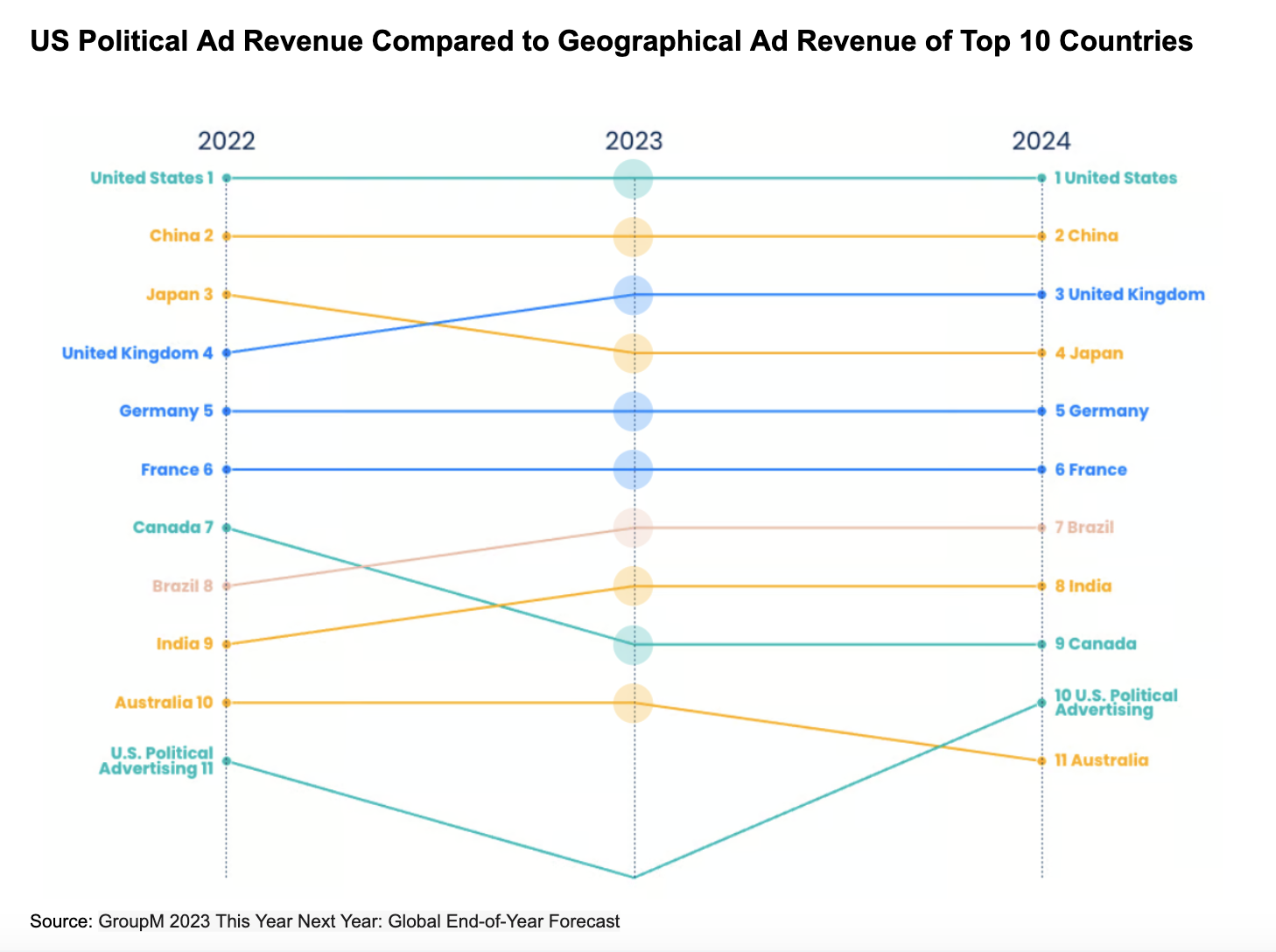
Much of that US ad spending will be directed to the local level, and $1.2 billion of that is expected to be spent on digital channels with better targeting capabilities, including CTV.
The cost per thousand (CPM) is also expected to increase, according to Initiative’s Robert Jackson, especially in battleground states such as Arizona, Wisconsin, Pennsylvania and Nevada. Additional risks are posed both by deepfakes created by generative artificial intelligence (AI) and the uneven approach of regulation across social platforms.
Marketers are wondering how to connect with consumers amid the noise, especially as some consumers are deeply invested in the political process and some just want to tune it all out. WARC partnered with research firm Ipsos to get an idea of US consumers' attitudes toward the current political and media climate. According to the Ipsos Consumer Tracker, fielded January 23–24, 2024, among the 1,119 U.S. adults surveyed, 59% were closely following the presidential election, while 41% were not. That’s two very different mindsets and commercial messages are likely to land differently depending on who’s viewing them.

Navigating the Red state/Blue state divide
Brands are increasingly sensitive about any messaging that might be construed as political, especially following the financial and reputational fallout that Bud Light faced last year after a promotion with transgender influencer Dylan Mulvaney. A single Instagram post led conservative consumers to denounce the beer brand and stage a boycott; the brand’s attempts to contain the fallout then angered progressives, leaving nobody happy.
But how to avoid being an equal opportunity offender when either side of the Red state/Blue state divide is willing to use your brand communications as an indicator of everything that is either right or wrong with America? Boycotts, and voting via pocketbook, are a political cudgel used by both left and right-leaning consumer groups who flood social feeds with posts targeting a brand, and often short-term sales will take a hit.
Consumers polled by Ipsos on whether they had stopped using any products or services from a company for political reasons turned up the good news that the majority of them had not. Less than a quarter of consumers stopped using a product or service for political reasons in the last three months, according to Ipsos Consumer Tracker.
Of those who had stopped using a product or service, 23% did so because of the company’s political leanings; 21% did so because of the company’s stance on a particular issue; and 15% did so because of publicized boycotts or protests against the company.
Attitudes versus action
There is usually, of course, a gap between what consumers say they will do and what consumers actually do. The percentage of consumers who indicated they would be prompted to take action because of a company’s political stance, for example, was much higher than the percentage that actually stopped using a product in the last three months.
When probed about their attitudes toward corporations taking a political or social stand on an issue by Ipsos, more consumers believe that politics would cause them to withdraw support. A much higher percentage of consumers (44%) say they are less likely to continue to support a brand with which they disagree.
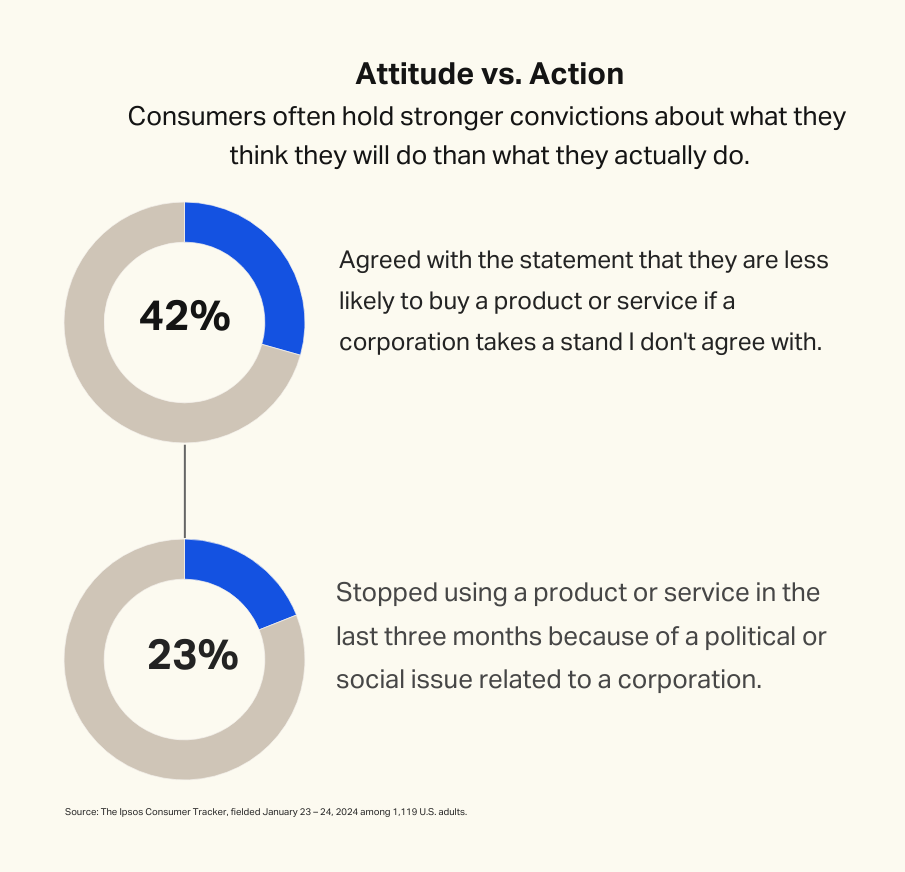
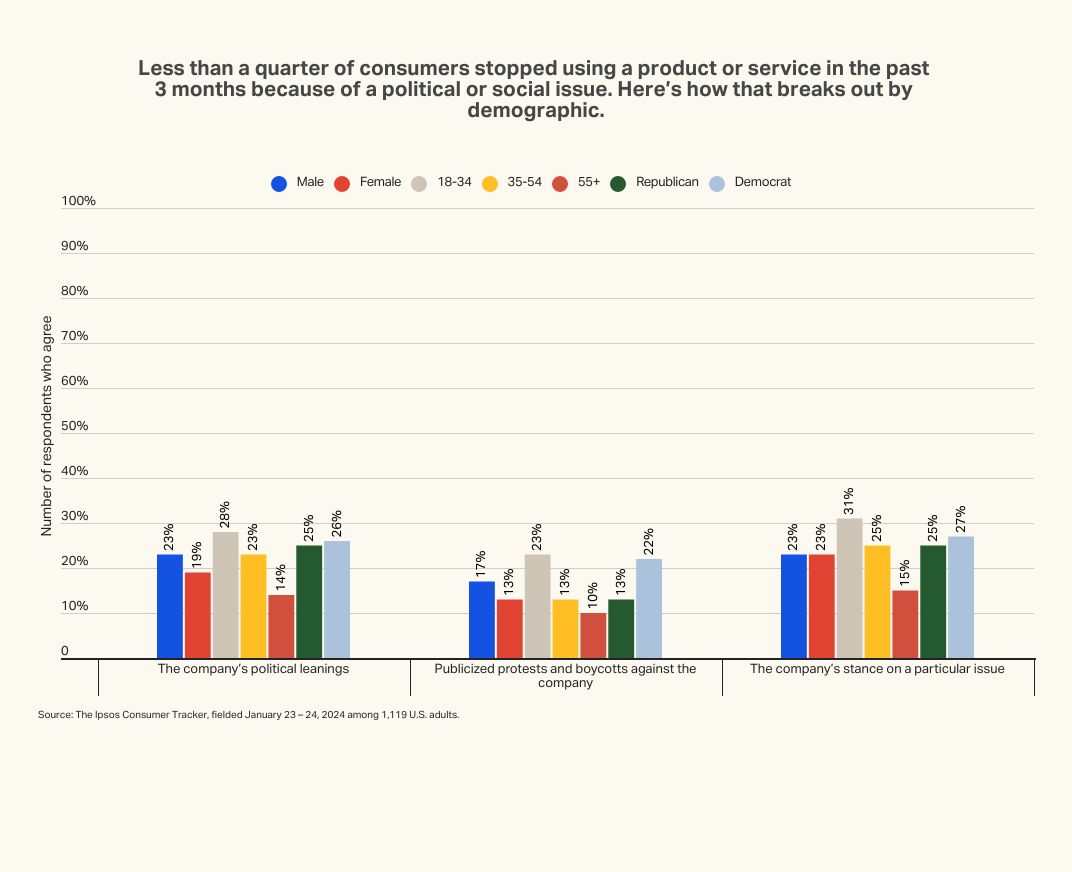
Protecting brand equity during a crisis
A brand staring into the glare of a politically-engineered controversy often seems to be in danger of suffering long-term damage.
However, brands with strong equity going into a crisis tend to be able to weather the storm of a political controversy. Brand intelligence platform BERA analyzed the performance of five brands that were caught in the political crosshairs – including Bud Light, Walt Disney Co., and Target – to see if there was a difference in perceptions in conservative-leaning Red states versus more progressive-leaning Blue states.
By looking beyond the most vociferous critics and the initial cycle of media coverage, BERA tracked how consumer perceptions before, during and after these crises influenced important brand metrics, revenue and shareholder value – and why the damage was more enduring for some brands than others.
After Florida’s state government in March 2022 passed the Parental Rights in Education Act, which limits instruction on gender identity and sexual orientation from kindergarten to third grade, enabling parents to more easily sue schools, Bob Chapek, then CEO of Disney – he departed in November 2022 – publicly spoke out the next day in support of the LGBTQ community. In apparent retaliation, on April 19, 2022, Florida’s governor Ron DeSantis signed a law to strip Disney of its self-governance privileges in the state of Florida – a long-standing privilege it had enjoyed in reflection of its financial importance to the region. What followed was a year-long battle between the state and the entertainment and theme park company. At the start of the crisis, Disney had some of the highest brand equity ratings in the BERA database versus the most important 2,000 brands in the U.S., and though brand equity took an immediate hit in both Red and Blue states – but it since recovered to its previous levels.
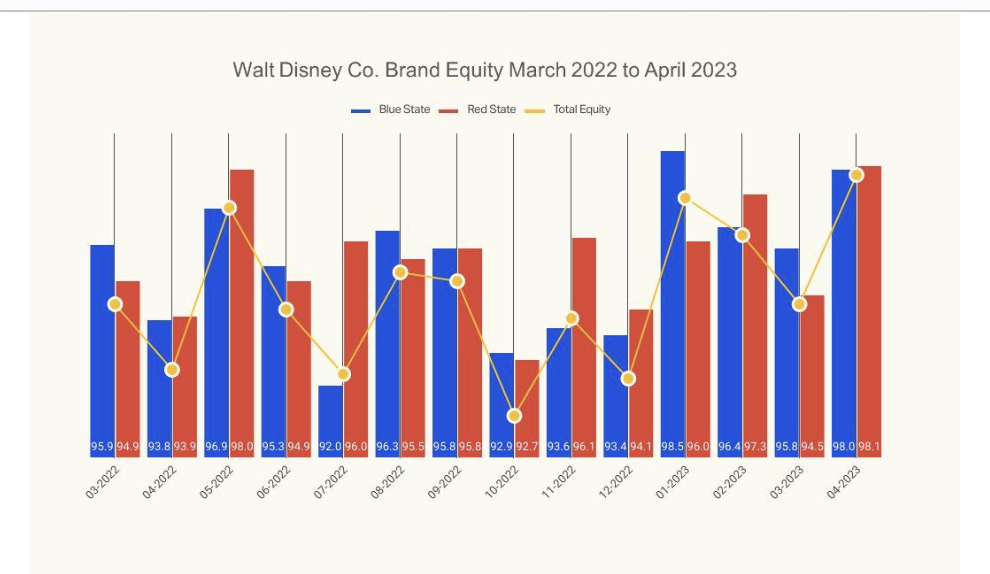
Source: BERA
Strong brand equity heading into a crisis helps to mitigate any potential damage, and investment in brand-building during times of non-crisis is critical to insulating brands when trouble inevitably arrives.
Nearly half of consumers in the Ipsos Consumer Tracker also said it’s important for corporations to stick by their stances on issues, even if it makes consumers angry. But that view is more prevalent for some demographic groups than others. Diving deeper and understanding the nuances is key.
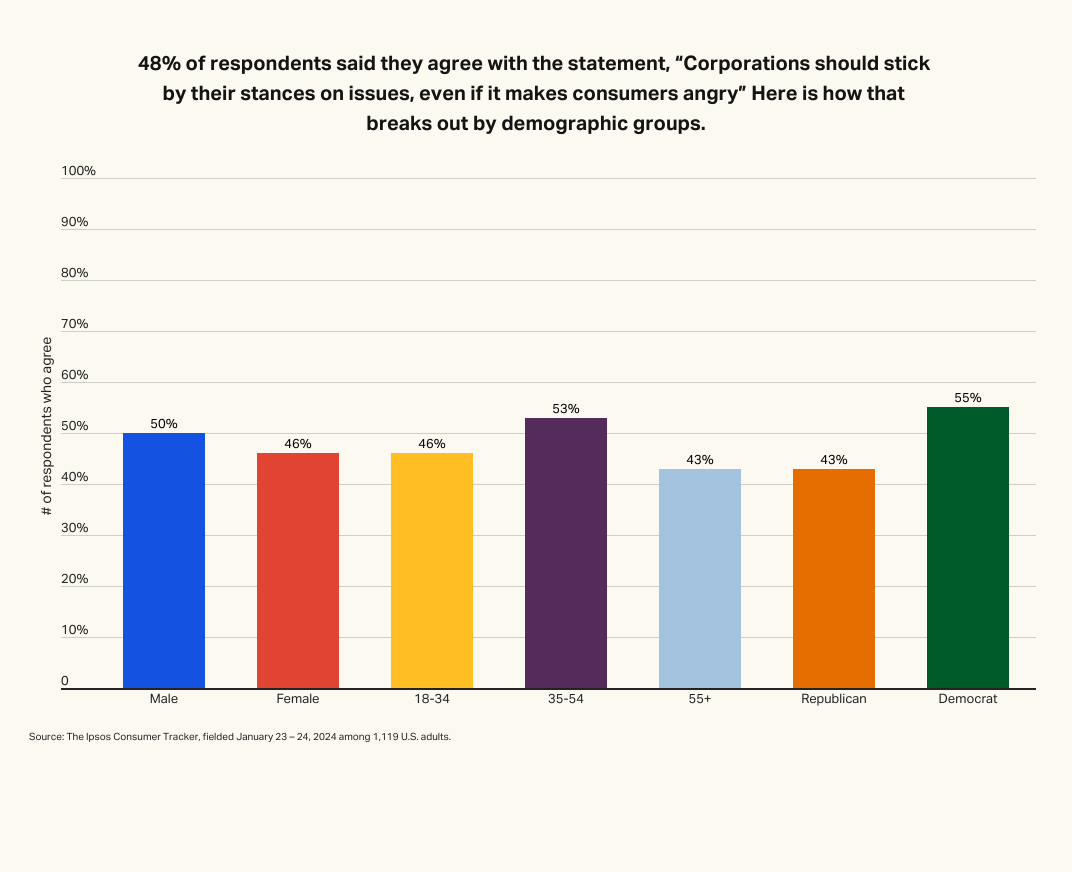
Tribal cues and storytelling beat rationality
Online yelling about a brand is not solely an action based on anger; people want to signal what side they are on. Tribalism is a powerful force, and it is on full display in this year’s presidential election thanks in large part to the influence of Donald Trump’s MAGA (Make America Great Again) movement. Dr. Marcus Collins dissects tribal behavior and the two-way influence that occurs between the leader of the tribe and the figurehead. The figurehead creates the spark of possibilities, and the tribe negotiates social coordination. It’s the influence of the tribe that moves the tribe. Understanding can inform both political and marketing strategies.
Part of a politician’s tribal appeal, as for any brand, rests in the narrative they create. In “Searching for the Angel’s Cocktail: How storytelling in political campaigns beats rationality, and what that reveals about connecting with consumers,” Accenture Song’s Stephen Lampert lays out how emotional storytelling triggers the release of oxytocin, a neurochemical often referred to as the ‘love hormone’, because it builds bonding, trust, empathy, and compassion” – the things that make us feel human.
Trust, empathy and compassion are definitely traits we will need as we navigate 2024. This article collection aims to help make this difficult road ahead a bit more manageable.
Read more in this Spotlight series
How a brand crisis plays out in Red states vs. Blue states
Michael Reh, Kraig Schulz, and Ken Favaro
BERA
US Ad Trends: Political advertising in a complex election cycle
Stephen Whiteside
WARC
Searching for the Angel’s Cocktail: How storytelling in political campaigns beats rationality, and what that reveals about connecting with consumers
Stephen Lampert
Accenture Song
Voting for “Us”: Tribalism takes over US politics
Dr Marcus Collins
University of Michigan

